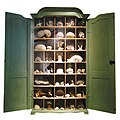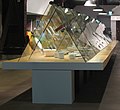
Back بوابة:متاحف Arabic প্রবেশদ্বার:জাদুঘর Bengali/Bangla Portail:Musées French Portale:Musei Italian Портал:Музеї Ukrainian Portal:图书馆和博物馆 Chinese
The Museums Portal
A museum is an institution dedicated to displaying and/or preserving culturally or scientifically significant objects. Many museums have exhibitions of these objects on public display, and some have private collections that are used by researchers and specialists. Compared to a library, a museum hosts a much wider range of objects and usually focus around a specific theme such as the arts, science, natural history, local history, and other topics. Public museums that host exhibitions and interactive demonstrations are often considered to be tourist attractions, and many museums attract large numbers of visitors from outside their host country, with the most visited museums in the world regularly attracting millions of visitors annually.
Since the establishment of the earliest known museum in ancient times, museums have been associated with academia and the preservation of rare items. Museums originated as private collections of interesting items, and not until much later did the emphasis on educating the public take root. (Full article...)
Selected museum

The Palazzo Pitti (Italian: [paˈlattso ˈpitti]), in English sometimes called the Pitti Palace, is a vast, mainly Renaissance, palace in Florence, Italy. It is situated on the south side of the River Arno, a short distance from the Ponte Vecchio. The core of the present palazzo dates from 1458 and was originally the town residence of Luca Pitti, an ambitious Florentine banker.
The palace was bought by the Medici family in 1549 and became the chief residence of the ruling families of the Grand Duchy of Tuscany. It grew as a great treasure house as later generations amassed paintings, plates, jewelry and luxurious possessions.
In the late 18th century, the palazzo was used as a power base by Napoleon and later served for a brief period as the principal royal palace of the newly united Italy. The palace and its contents were donated to the Italian people by King Victor Emmanuel III in 1919.
The palazzo is now the largest museum complex in Florence. The principal palazzo block, often in a building of this design known as the corps de logis, is 32,000 square metres. It is divided into several principal galleries or museums detailed below. (Full article...)
Selected interior image
Selected general article

Collection maintenance is an area of collections management that consists of the day-to-day hands on care of collections and cultural heritage. The primary goal of collections maintenance or preventive conservation is to prevent further decay of cultural heritage by ensuring proper storage and upkeep including performing regular housekeeping of the spaces and objects and monitoring and controlling storage and gallery environments. Collections maintenance is part of the risk management field of collections management. The professionals most involved with collections maintenance include collection managers, registrars, and archivists, depending on the size and scope of the institution. Collections maintenance takes place in two primary areas of the museum: storage areas and display areas.
Collection maintenance and its tasks all work as a means to continually observe the condition of collections and ensure they are properly maintained and cared for. Because museums and repositories are stewards of cultural property in the public trust, they have a "responsibility to provide reasonable care for the objects entrusted" to them. Museum's collections maintenance tasks can also involve assessing and implementing strategies to improve storage areas and containers while continuously monitoring environmental conditions that may affect objects. (Full article...)
Did you know...
- ... that for fifteen years Joseph Henry Gest was both the director of the Cincinnati Art Museum and the president of the Rookwood Pottery Company, spending mornings at one and afternoons at the other?
- ... that the firm of Israel Sack supplied American antiques to leading private collectors and museums, including the Winterthur Museum, The Henry Ford, and the Metropolitan Museum of Art?
- ... that Lamia Al-Gailani Werr helped rebuild the Iraq Museum after it was looted in the 2003 American-led invasion of Iraq?
- ... that the Paul Delvaux Museum exhibits not only Paul Delvaux's paintings, but also a collection of model trains?
- ... that before writing The Space Museum, Glyn Jones had never seen Doctor Who?
- ... that the FBI set up temporary offices in a museum on an aircraft carrier while investigating the 9/11 terrorist attacks?
Get involved
For editor resources and to collaborate with other editors on improving Wikipedia's Museums-related articles, see WikiProject Museums.
Selected exterior image
Selected type of museum
A national history museum or national historical museum is a history museum dedicated to presenting artifacts and exhibits reflecting the history of a particular nation, usually its home country. The earliest public museums, the Ashmolean Museum in Oxford and the Louvre Museum in Paris, were focused on natural history and art, respectively, and not necessarily on subjects related to the history of any nation. Following Napoleon's use of the Louvre as a center of national pride during his reign, other countries began to use museums not just to store artifacts of aesthetic or educational value, but to portray the country itself in a positive light.
Historically, some national history museums have been used purely as propaganda tools through which governments attempt to convey an official history. For example, "the Nazi regime employed the museum as a deliberate tool of propaganda and 'public education'". It has further been argued that "the very idea of an officially sponsored national history museum is simply outdated" in light of the trend towards pluralistic interpretation of artifacts. On the other hand, it has been argued that: "To create a national history museum that discards unitary national narratives as well as causal trajectories (the teleology of the nation)—in effect to subvert the form—is probably impossible". One concern of national history museums, therefore, is how to fairly and neutrally depict negative periods in a nation's own history. (Full article...)

















































